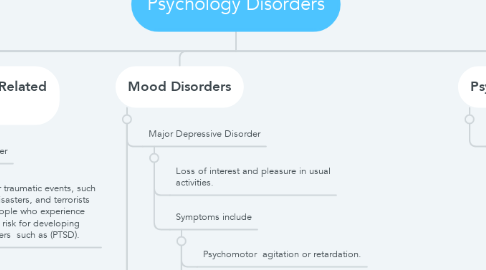
1. Anxiety Disorders
1.1. Phobias
1.1.1. Intense, unreasonable and persistent fear caused by the presence or anticipation of a specific object or situation.
1.2. Social Anxiety Disorder
1.2.1. Extreme and persistent fear or anxiety and avoidance of social situations in which the person could potentially be evaluated negatively by others.
1.3. Panic Disorder
1.3.1. Common symptoms of panic attack:
1.3.1.1. Head: Feeling dizzy, unsteady, light headed.
1.3.1.2. Chest: Chest pain, palpitations and/or accelerated heart rate.
1.3.1.3. Lungs: Shortness of breath.
1.3.1.4. Stomach: Nausea or abdominal distress.
1.4. Generalized Anxiety Disorder
1.4.1. Is a relatively continuous state of excessive, uncontrollable, and pointless worry and apprehension.
2. Obsessive-Compulsive and Related Disorders
2.1. Obsessive-Compulsive disorder
2.1.1. People with this disorder experience thoughts and urges that are intrusive and unwanted and/or the need to engage in repetitive behaviors or mental acts.
2.2. Body Dysmorphic Disorder
2.2.1. The person is preoccupied with a perceived flaw in their physical appearance that is either nonexistent or barely noticeable to other people.
2.3. Hoarding Disorder
2.3.1. People with hoarding disorder cannot get rid of personal possessions, regardless of how valueless or useless these possessions are.
2.4. Causes of OCD and related disorders
2.4.1. The disorder is five times more frequent in the first-degree relatives of people with OCD than in people without the disorder.
2.4.2. The concordance rate of OCD among identical twins is 57%.
3. Trauma and Stressor Related Disorders
3.1. Posttraumatic Stress Disorder
3.1.1. Extremely stressful or traumatic events, such as combat, natural disasters, and terrorists attacks, place the people who experience them at an increased risk for developing psychological disorders such as (PTSD).
4. Mood Disorders
4.1. Major Depressive Disorder
4.1.1. Loss of interest and pleasure in usual activities.
4.1.2. Symptoms include
4.1.2.1. Psychomotor agitation or retardation.
4.1.2.2. Depressed mood most of the day (feeling sad, empty, hopeless, or appearing tearful to others).
4.1.2.3. Significant weigh loss or gain or decrease or increase in appetite.
4.2. Major Depressive Disorder symptoms to receive a Diagnosis
4.2.1. Feeling overwhelmingly sad most of each day.
4.2.2. Fatigue or loss of energy.
4.2.3. Feelings of worthlessness or guilt.
4.2.4. Difficulty concentrating and indecisiveness.
4.3. Difficulty falling asleep or sleeping too much.
4.4. Bipolar Disorder
4.4.1. Symptoms can range from the extreme sadness and hopelessness of depression to the extreme elation and irritability of mania.
4.4.2. Mood states that vacillate between depression and mania.
4.4.3. DSM-5 says: a manic episode is characterized as a ¨distinct period of abnormally and persistently elevated, expansive, or irritable mood and abnormally and persistently increased activity or energy lasting at least one week.
4.4.4. Symptoms of mania:
4.4.4.1. Excessively talkative.
4.4.4.2. Mood that is almost euphoric.
4.4.4.3. Spontaneously starting conversations with strangers.
4.4.4.4. Excessively irritable.
4.4.4.5. Abruptly witching from one topic to another.
4.4.4.6. May exhibit grandiosity.
4.4.4.6.1. Subtypes of Depression Include
5. Psychotic Disorders
5.1. Schizophrenia
5.1.1. The person´s thoughts, perceptions, and behaviors are impaired to the point where he/she is not able to function normally in life.
5.1.2. Symptoms
5.1.2.1. Hallucinations.
5.1.2.2. Disorganized thinking.
5.1.2.3. Disorganized or abnormal motor behavior.
5.1.2.4. Negative symptoms
5.1.3. Delusions.
5.1.4. Causes
5.1.4.1. Genetic vulnerability and environmental stress.
5.1.4.2. Obstetric complications.
5.1.4.3. Marijuana use.
6. Dissociative Disorders
6.1. Characterized by an individual becoming split off, or dissociated, from her core sense of self.
6.2. Memory and identity become disturbed.
6.3. These disturbances have a psychological rather than physical cause.
6.4. Dissociative amnesia
6.4.1. The individual is unable to recall important information.
6.4.2. It usually follows an extremely stressful or traumatic experience.
6.5. Depersonalization/Derealization Disorder
6.5.1. Depersonalization: the person believes his/her movements, thoughts and feelings are not their own.
6.5.2. Derealization: The person feels that the world surrounding them is not real.
6.6. Dissociative Identity Disorder
6.6.1. Formerly called multiple personality disorder.
6.6.2. People exhibit two or more separate personalities or identities, each well-defines and distinct from one another.
6.6.3. Causes
6.6.3.1. About 95% of the people with DID were physically and/or sexually abused as children.
7. Personality Disorder
7.1. Exhibit a personality style that differs markedly from the expectations of their culture, is pervasive and inflexible, begins in adolescence or early adulthood, and causes distress or impairment.
7.1.1. Cluster A: Odd and Excentric
7.1.1.1. Paranoid
7.1.1.2. Schizoid
7.1.1.3. Schizotypal
7.1.2. Cluster B: Impulsive, dramatic, erratic
7.1.2.1. Antisocial
7.1.2.2. Histrionic
7.1.2.3. Narcissistic
7.1.2.4. C
7.1.3. Cluster C: Nervous and fearfull
7.1.3.1. Avoidant
7.1.3.2. Obsessive compulsive
7.1.3.3. Dependent

